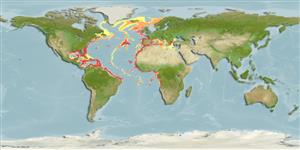Issue
This species is often confused with Nezumia sclerorhynchus (Valenciennes, 1838).
Environment: milieu / climate zone / depth range / distribution range
Écologie
marin benthopélagique; non migrateur; profondeur 200 - 2320 m (Ref. 3587), usually 200 - 1000 m (Ref. 2683). Deep-water; 70°N - 12°S, 98°W - 30°E (Ref. 1371)
Atlantic Ocean: Eastern Atlantic: Faroe Bank to northern Angola and the Mediterranean Sea. Western Atlantic: Davis Straits to northern Brazil.
Length at first maturity / Taille / Poids / Âge
Maturity: Lm 4.5, range 4 - ? cm
Max length : 36.0 cm TL mâle / non sexé; (Ref. 3587); common length : 25.0 cm TL mâle / non sexé; (Ref. 2683); âge max. reporté: 9 années (Ref. 58045)
Épines dorsales (Total) : 2; Épines anales: 0. Head short, completely scaled except for naked strip on the ventral surface of the snout; Eyes relatively large, 29 to 42% of head length; snout short, pointed; chin barbel very short. Body scales with lanceolate to shield-shaped spinules. Overall color is bluish to violet, head somewhat tawny to swarthy; ventral portions silvery when fresh; pelvic fins black except outermost ray which is pale to white; oral cavity grayish; branchial cavity mostly black.
Feeds on benthic as well as pelagic animals like mysids, amphipods, small shrimps, copepods, isopods, ostracods and polychaete worms (Ref. 6187).
Life cycle and mating behavior
Maturité | Reproduction | Frai | Œufs | Fécondité | Larves
Cohen, D.M., T. Inada, T. Iwamoto and N. Scialabba, 1990. FAO species catalogue. Vol. 10. Gadiform fishes of the world (Order Gadiformes). An annotated and illustrated catalogue of cods, hakes, grenadiers and other gadiform fishes known to date. FAO Fish. Synop. 125(10). Rome: FAO. 442 p. (Ref. 1371)
Statut dans la liste rouge de l'IUCN (Ref. 130435: Version 2024-2)
Menace pour l'homme
Harmless
Utilisations par l'homme
Pêcheries: intérêt commercial mineur
Outils
Articles particuliers
Télécharger en XML
Sources Internet
Estimates based on models
Preferred temperature (Ref.
123201): 4.7 - 15.7, mean 9.3 °C (based on 786 cells).
Phylogenetic diversity index (Ref.
82804): PD
50 = 0.5000 [Uniqueness, from 0.5 = low to 2.0 = high].
Bayesian length-weight: a=0.00186 (0.00113 - 0.00306), b=3.12 (2.97 - 3.27), in cm total length, based on LWR estimates for this species & (Sub)family-body (Ref.
93245).
Niveau trophique (Ref.
69278): 3.3 ±0.1 se; based on diet studies.
Résilience (Ref.
120179): Faible, temps minimum de doublement de population : 4,5 à 14 années (Preliminary K or Fecundity.).
Fishing Vulnerability (Ref.
59153): Low to moderate vulnerability (26 of 100).
Nutrients (Ref.
124155): Calcium = 21.3 [10.3, 49.2] mg/100g; Iron = 0.34 [0.16, 0.70] mg/100g; Protein = 15.9 [14.1, 17.5] %; Omega3 = 0.248 [0.102, 0.566] g/100g; Selenium = 26.9 [9.5, 68.2] μg/100g; VitaminA = 16.6 [3.0, 84.1] μg/100g; Zinc = 0.505 [0.312, 0.823] mg/100g (wet weight);
